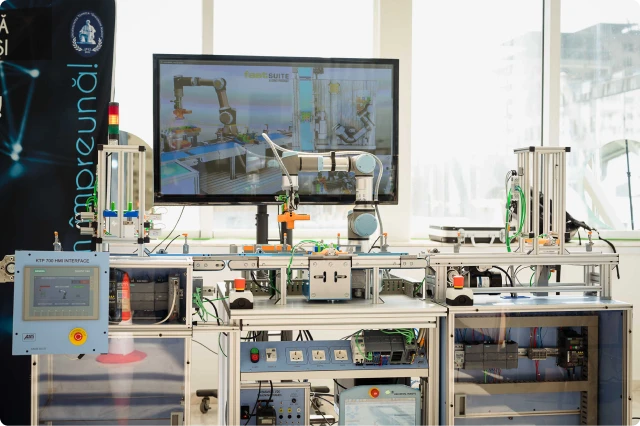Test before invest
The digital twin has as its central point the generation and use of a virtual replica of a real system. In industrial production, with the help of the digital twin, a company can test and validate a product even before it physically exists.
One of the main challenges of digital transformation is the uncertainty associated with investing in new technologies. Small problems that may arise during the process may involve an increase in costs for the beneficiary if they have to stop the production process or if delays occur. By creating a replica of a planned manufacturing process, the digital twin allows engineers to identify any process flaws before the product goes into production.
Users can perturb the system to synthesize unexpected scenarios, examine the system’s reaction, and identify appropriate mitigation strategies. According to the implementations made on the Romanian market by the company COBOTWARE, the use of this technology offers an increase in the speed of adoption of robotic technologies by 40%, an increase in flexibility for initial studies by 30% and an increase in the speed of delivery of automation solutions by 40 %.
In the field of health and medicine, modern technologies allow the construction of personalized models of patients or organs of the human body that provide the biochemical, physiological, anatomical and functional behavior of the physical system.
These models are periodically updated with data from various sources, such as clinical and laboratory measurements, wearable devices and biomedical sensors. By integrating machine learning models and virtual and augmented reality with the digital twin, specialists can personalize therapies or reduce the need for invasive procedures. Additionally, digital twin-based models are useful in examining various diseases, drug interactions, and medical devices.


Although digital twin technology has become mainstream for industrial giants, the reality is very different for most small and medium-sized manufacturing companies. The main obstacles they face are a lack of digital capabilities and resources for adoption and a lack of understanding of the benefits (such as return on investment).
DIZ specialists provide consultancy in the field of creating a replica of the production process. You will have access to a high-performance infrastructure for testing and experimenting with the appropriate technologies (CAD software, industrial robot infrastructure, simulation software, etc.) and you will be able to analyze and experience working scenarios with digital twins such as the use of robots in manufacturing processes. Assembly.
Together we will walk the path from understanding the digital twin technology and the benefits for your company to identifying funding and collaboration opportunities to make the digital twin a reality for your business.
The digital twin in medicine (GDM) is defined as the virtual representation (“digital twin”) of the patient (“physical twin”) that is generated from multimodal patient data, population data, and real-time updates of environmental variables and vital parameters of the patient.
With GDM, random perturbations of the digital twin can be modeled to gain insight into the expected behavior of the physical twin. The technology is based on two technical concepts: cyber-physical systems (SCF) and closed-loop optimization (OBI). SCF in turn consists of artificial intelligence systems (AIS) that imitate human reasoning based on big data and pattern recognition and the internet of things (IoT) that allows data synchronization between the two digital and physical twins. OBI enables the use of real-time data to monitor, diagnose and optimize treatment.
We provide consultancy in building a virtual replica of the intra-hospital space and the patient. Thus, single cases of intra-hospital infection can be prevented, as well as limiting the effects and spread of intra-hospital infection epidemics, by using visualizations and reports that facilitate the work of epidemiologists in identifying patient zero and transmission routes. This is possible by real-time monitoring of the clinical environment, the presence of people in a room, the detection of their actions and the monitoring of several clinical scenarios that are known to play a role in the transmission of intra-hospital infections.
Defining an avatar (virtual replica) of the patient and immersing the patient in the virtual environment through the avatar redefines the notion of neuromotor recovery. The patient can thus benefit from continuous guidance from an interactive virtual therapist while performing recovery exercises.
Digitalization Solutions